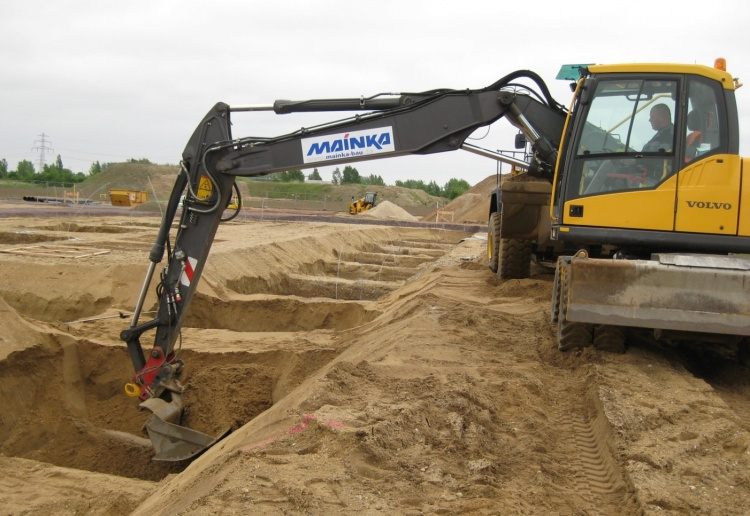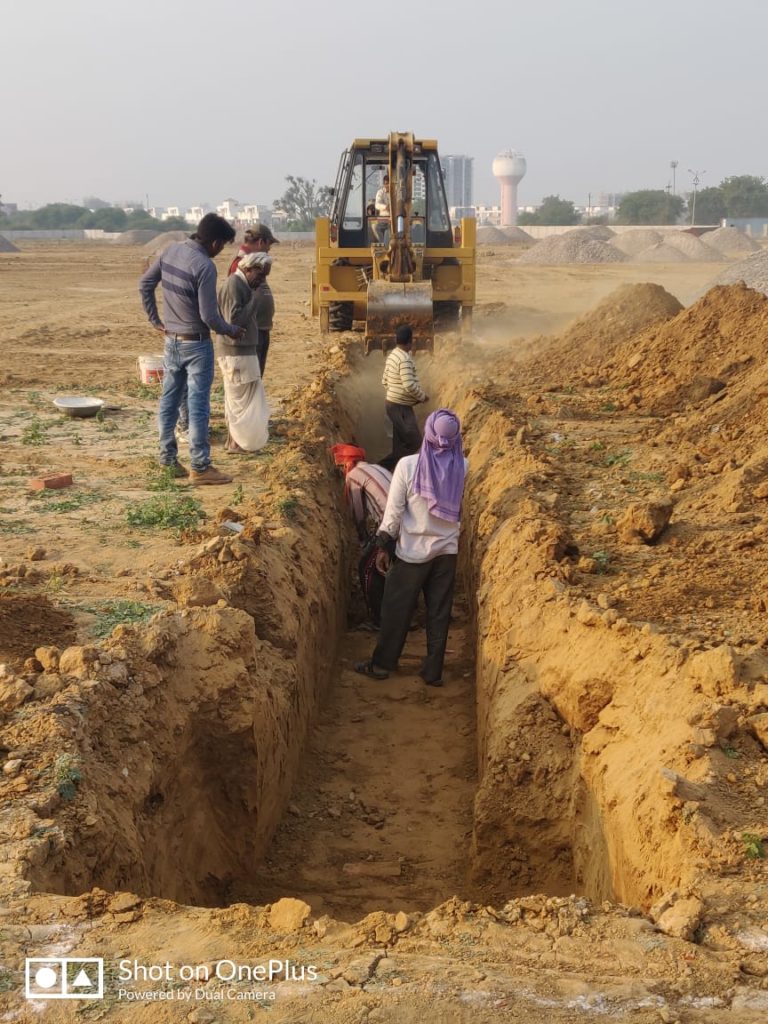Earth work excavation for foundation
This How to calculate earth work excavation for foundation article covers the works specification of earthwork in excavation in all kinds of soils including murrum, hard murrum, soft rock (without blasting, hard rock (without blasting), rock (with blasting).

List of IS Code for earthwork excavation
The following Bureau of Indian Standard Code shall be applicable. In all cases, for the earth work the latest revision of the codes shall be referred to.
- Safety code for blasting and related drilling operations IS – 4081
- Method of measurement of building works IS – 1200
- Safety code for excavation work IS – 3764
- Code of practice for measurement of Civil Engineering works IS – 3385
- IS – 2720 Part II Determination of moisture content.
- Determination of moisture content dry density relation using light compaction.
- Determination of dry density of soils, in-place by the sand replacement method.
- Determination of dry density of soils, in-place, by the core cutter method.
Drawings for earth work excavation for foundation
Drawings for earth work excavation for foundation should contain all necessary drawings showing the areas to be excavated, filled, sequence of priorities etc. Engineer at site shall follow strictly such drawings.
What are the processes of excavation in construction?
1. Client/Contractor/Builder shall obtain valid royalty for soil from concern government department before starting of excavation and
2. Client/Contractor/Builder shall carry out the survey of the site before excavation and set properly lines and establish levels for various works such as earthwork in excavation for levelling, basement, foundations, plinth filling, roads, drains, cable trenches, pipelines etc. Such survey shall be carried out by taking accurate cross sections of the area perpendicular to establish reference/grid lines at 5 m intervals or nearer as determined by site Engineer based on ground profile. These shall be checked by Engineer and thereafter properly recorded.
3. The area to be excavated/ filled shall be cleared of fences, trees, plants, logs, slumps, bush, vegetation’s, rubbish slush etc. and other objectionable matter. If any roots or stumps of trees are found during excavation, they shall also be removed. The material so removed shall be burnt or disposed of. Where earth fill is intended, the area shall be stripped of all loose/soft patches, top soil containing deleterious matter/materials before fill commences.
How to repair cracks in concrete Surfaces| Concrete Crack Repair Guide
Different ways of earth work excavation for foundation

Earth Work in Excavation Manually for depth up to 1.5m from Existing GL:
a) Classification: Any earthwork will be classified under any of the following categories.
i) All kinds of soils: These shall include all kinds containing kankar, sand, silt, murum and / or shingle, gravel, clay, loam peat, ash, shale etc. which can generally be excavated by spade, pick-axe , shovel and JCB which is not classified under soft and decomposed rock, and hard rock defined below. This shall also include embedded rock boulders not bigger than 1metre in any dimension and not more than 200 mm in any one of the other two dimensions.
ii) Soft Rock: This shall include rock, boulders, slag, chalk, slate, hard mica schist, laterite etc. which are to be excavated with or without blasting or could be excavated with jcb, poclain with bucket, ripper, chisel, picks, hammer, crow bars, wedges etc. This shall also include excavation in macadam and tarred roads and pavements. This shall also include rock boulders not bigger than 1 metre in any dimension and not more than 500 mm in any one of the other two dimensions Rubble masonry to be dismantled will also be measured under this item.
iii) Hard Rock: This shall include rock which cannot be easily excavated with pick-axes, hammer, crow bars, JCB and wedges but has to be either heated where blasting is prohibited or has to be blasted. They shall be stacked separately for measurement.
This shall comprise any rock or cement concrete or RCC, the excavation of which cannot be carried out by using mechanical / hydraulic excavators and where blasting is resorted.
Site In charge opinion as to the particular rock requires blasting or not shall be final and binding. Any secondary blasting / breaking of blasted boulders is required will have to be carried out at site before stacking.
After blasting, blasted rock capable of being lifted by hand together with spalls should be stacked at site
b) The earth work in excavation shall be done as per the Architect and structural consultant’s drawings up to required depths and levels and alignments in all sorts of soils. The depth of the foundation will be as per the Engineer’s instructions. The lining work should be done by the Site Engineer.
Roots or trees met with during the excavation shall be cut and smeared with coal tar. Excavated earth shall be stacked at least 3 m away from the trenches, so that it may not damage the sides of the excavated trenches. The sides of the excavated trenches shall be vertical and in straight line and bottom uniformly levelled watered, consolidated and ready for termite treatment.
c) In firm soil if the excavation is deeper than 2 m the sides of the trenches shall be made bigger by allowing steps of 50 cm on either side so as to keep the slope 0.25 to 1. In loose soft or slushy soil the width of the step shall be suitably increased or the sides sloped or shoring and strutting may be done.
d) For excavation for drain work, the sides and the bottoms should be to the required slope, shape and gradient. The cutting shall be done from top to bottom. Under no circumstances shall undermining or under cutting be allowed. The final surface shall be neatly levelled and well compacted. The earth from the cutting shall be directly used for filling either in plinth or on grounds.
e) The foundation trenches shall be free from water and muck, while the foundation work is in progress.
Safety measures during excavation work of foundation
1. Adequate protective measures shall be taken by the engineer to see that the excavation for the building foundation does not affect the adjoining structure’s stability and safety.
2. Engineer should take precaution for the safety of the people, property or neighbour’s property to avoid negligence during the constructional operations.
3. To the extent available, excavated materials shall be used as backfill. Fill material shall be free from clods, salts, sulphates, organic & other foreign material. All large particle of earth shall be broken or removed. Where excavated material is mostly rock, the boulders shall be broken into pieces not larger than 150 mm size, mixed with properly graded fine material consisting of murum.
4. As soon as the work in foundations has been accepted and measured, the spaces around the foundations, structures, pits, trenches etc. shall be cleared of all debris and filled with earth in layers 15 cm to 20 cm, each layer being watered, rammed and properly consolidated before the succeeding one is laid. Each layer shall be properly consolidated.
How to calculate earth work excavation for foundation
Mode of Measurement for Earth Work in Excavation is generally Including Back Filling: To calculate earth work excavation for foundation. We have to find out the volume of the foundation.
For Example- Length of Foundation = 4 meter

Depth of the Foundation = 1.5 Meter
Then Value of earth work excavation for foundation= 4x3x1.5=18 Cubic Meter
These are used for the Measurement for Earth Work in Excavation, in foundation, basement, raft, pits, trenches, underground, septic tank, soak wall etc.
Note: – This includes the cost of Earth work for the excavation Lead for deposition/disposal of excavated material, shall be as specified in the other item of work. That should be paid extra.
Leave a Reply